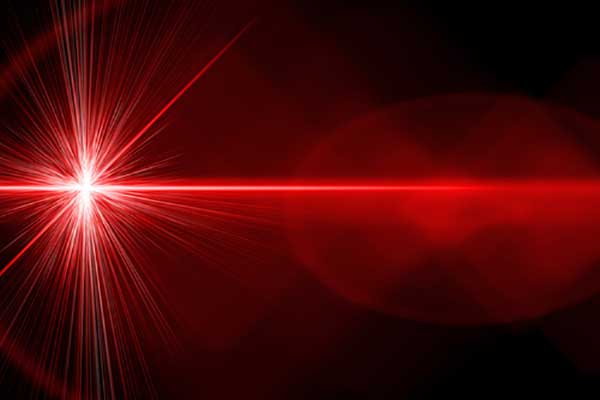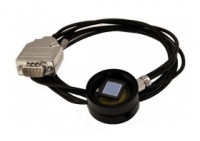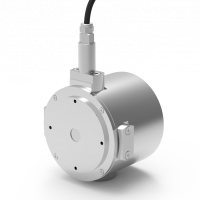
Laser Power Measurement
Laser Power Measurement
Lasers are widely used in many different applications today. Optical communications, laser printing, material processing, distance measurement (LiDAR), medicine and mass spectrometry to name a few.
For many of these applications, the power (peak power, average power, pulse shape) or energy as well as the stability of the laser being used must be measured in order to control for instance the safety according to safety standards like Artificial Optical Radiation Directive 2006/25/EC or laser classification according to EN 60825-1 classification. For such kind of measurements, the combination of a photodiode-based sensor and an electronic read-out device (Optometer) can be used.
The photodiode is converting the incoming laser radiation into an electrical current which is read out by the optometer. With the help of a radiometric calibration (e.g. by the ISO 17025 accredited calibration laboratory of Gigahertz-Optik) the optometer will show the resulting optical power (in W) at the desired wavelength.
This well-established measurement concept works for CW-sources as well as pulsed sources. For pulsed sources, the average power is normally measured. Therefore, the integration time and the pulse frequencies must be matched.
Sometimes also the pulse shape is needed, see App 022 covering laser pulse shape measurement or dual detector sphere for laser power and laser waveform measurement. The optometer can also take the measurement time into account and integrate the laser power over time, showing directly the resulting energy/laser dose (in J).
The minimum and maximum power that can be measured are determined by the combination of detector and optometer being used. Our products usually cover a very large power range from few nW up to kW due to our multi-gain range transimpedance amplifiers
Pulse Energy Measurement/Dose Measurement
With the optometer classical laser power meter P-9710 and its successor the modern touchscreen laser power meter P-21, Gigahertz-Optik also offers a precise optometer to measure incoming pulse energy. This measurement is using the principle of the so-called pulse-stretching method.
Any incoming signal from the photodiode is stretched in time in order to fit to the rise-time of the optometer’s built-in transimpedance amplifier.

During this stretching, the energy remains constant (area A1 = A2) but area A2 can be much higher sampled which results in a more precise measurement compared to area A1. The final results show the laser energy (in J) on the detector during the measurement. This offers the ability to precisely measure pulse energies of pulse chains as well as single pulses down to the ns range. For single pulses a trigger possibility is offered.
Detector Setups
For laser power measurement applications, two different types of detectors are widely used.
Photodiode without further accessories:

This setup is the most basic one. It consists of a wired photodiode inside a metal housing connected to an optometer. Due to the high linearity of photodiodes, this setup provides precise reading of low as well as medium power lasers.
Since the diode can only measure optical radiation or light which impinges on its active area, the laser spot on the diode must be smaller compared to the dimensions of the photodiode’s active area in order to measure its total power accurately. This limits the laser spot diameter to a certain extent (typically a few mm). Furthermore, the maximum power is limited by the photodiode’s responsivity, linearity (saturation) and the optometer's maximum input current (typical max. values are in the range of a few mW). Of course, optical density filters (ND filters) can be used to a certain extend.
Pure photodiode detectors can be used for CW, pulse energy as well as pulse shape analysis (rise-time of the diode must be considered).
- Pros: Very high sensitivity, fast response time
- Cons: Limited laser spot size, limited maximum power
Integrating sphere-based detector:

This detector concept is built by adding a photodiode onto a hollow sphere with highly reflective inner coating, a so-called integrating sphere. This setup is then calibrated in our ISO 17025 calibration laboratory. In order to measure optical power accurately, all optical radiation must be coupled into the integrating sphere through its entrance port.
For this concept/measurement setup the flexibility is much larger, since the range of sphere diameters we can offer ranges from 8 mm to 1 m. Hence it is possible to design measurement ports (integrating sphere entrance port) accordingly and large laser beam diameters or highly divergent beams can be measured if needed. Optical power levels can be adjusted more easily by a combination of optical density filters and the sphere diameter (attenuation by larger spheres). Additionally, the dynamic range can be extended by using multiple photodiodes in one integrating sphere for different optical power ranges. In total this approach permits maximum laser powers of more than 100W to be still measured correctly.
However, when measuring short pulses (ns range), larger integrating sphere lead to pulse stretching due to the light’s propagation time inside the sphere resulting from multiple reflections. Hence for pulse shape analysis, only small spheres can be used or the sphere diameter needs to be adjusted to the expected pulse length. Also dual detector setups are possible to address the specific needs. Here we can offer our support and experience depending on the laser parameter and provide you with the best solution for your application. See for instance our 16 mm ISD-1.6-SP innovative dual sensor integrating sphere which is among others used for lidar laser characterization.
Gigahertz-Optik offers standard sphere systems as well as highly flexible customized setups. This leads to various geometries as well as diode combinations being possible. See our Modular Integrating Sphere Concept for individual Laser Power Meters/Sphere Systems for further details here.
- Pros High sensitivity, flexibility, large power range possible, multidetector solutions
- Cons: Stretching of pulsed signals (relevant only for pulse shape measurements in ns range), larger size
Calibration
For any kind of radiometric laser power measurement, the calibration plays a key role for the precision of the final result. In other words, a low calibration uncertainty which you can trust is important. In that respect we offer laser power calibrations certified in our DAkkS ISO 17025 accredited calibration and testing laboratory. This means highest standards according to the ISO 17025 are applied to the processes to ensure reliability and traceability of our calibrations. All calibrations are directly traceable to the PTB, the German NMI, or comparable NMIs. Our calibration laboratory covers the wavelength range from 200 nm – 2500 nm.
Products
Here you can get a first overview of our products Radiometeres for Laser Radiation/Laser Power Meters. Also our Spectroradiometers for Radiometry/Spectrometer for Laser Power Measurements can be combined with integrating spheres for spectral laser power measurements. Please contact us for further information.